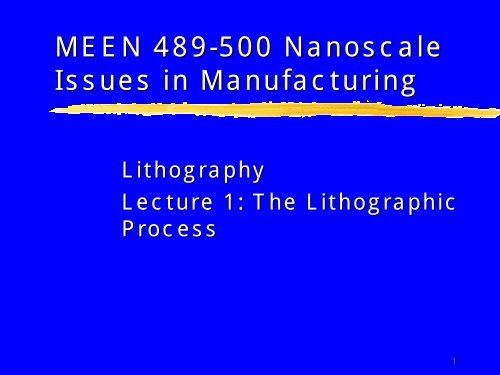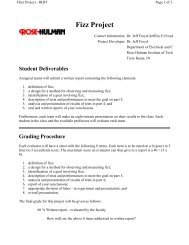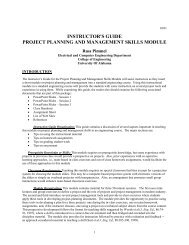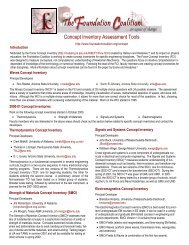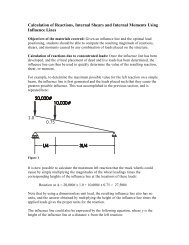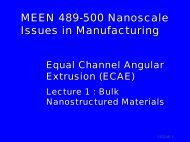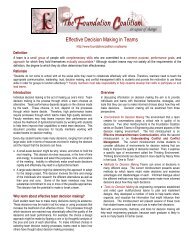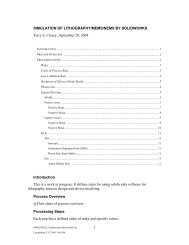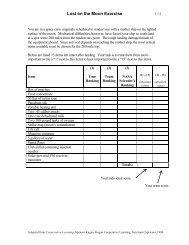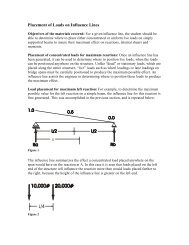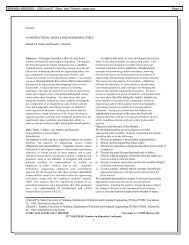Lithography Lecture No. 1 - Foundation Coalition
Lithography Lecture No. 1 - Foundation Coalition
Lithography Lecture No. 1 - Foundation Coalition
You also want an ePaper? Increase the reach of your titles
YUMPU automatically turns print PDFs into web optimized ePapers that Google loves.
MEEN 489-500 Nanoscale<br />
Issues in Manufacturing<br />
<strong>Lithography</strong><br />
<strong>Lecture</strong> 1: The Lithographic<br />
Process<br />
1
Discuss Reading Assignment<br />
1 1 Introducing Nano<br />
2 2 Size Matters<br />
3 3 Interlude One-The Fundamental Science<br />
Behind Nanotechnology<br />
Electrons, Atoms, Ions, Molecules<br />
Metals, Ceramics, Polymers<br />
Biosystems<br />
Electrical Conduction and Ohm’s Law<br />
Quantum Effects<br />
Optics<br />
2
Nanofabrication - 2 principal<br />
approaches<br />
Top-Down<br />
Miniaturizing existing<br />
processes at the<br />
Macro/Microscale<br />
Traditional approach in<br />
industrial applications<br />
E.g. <strong>Lithography</strong>, backbone of<br />
computing systems<br />
Bottom-Up<br />
Assembling structures from<br />
the atomic/molecular level<br />
<strong>No</strong>vel approach, conceptually<br />
imitating nature<br />
E.g. chemical self-assembly<br />
3
<strong>Lithography</strong><br />
<strong>Lithography</strong> in Art<br />
How lithography works<br />
Materials used for lithography drawing<br />
Photolithography<br />
Photolithographic process<br />
4
<strong>Lithography</strong> in Art<br />
Invented by Alois Senefelder in 1798<br />
Used for book illustrations, artist's prints,<br />
packaging, posters etc.<br />
In 1825, Goya produced a series of lithographs.<br />
In the 20 th and 21 st century, become an<br />
important technique with unique expressive<br />
capabilities in the Art field<br />
5
How <strong>Lithography</strong> started<br />
<strong>Lithography</strong> (Greek for "stone<br />
drawing") relies on the fact that<br />
water and grease repel<br />
Draw a pattern onto a flat stone<br />
surface with a greasy substance<br />
Paint the printing ink onto the<br />
stone<br />
While the stone background<br />
absorbs water, the greasy<br />
substance retains wet ink on top<br />
Press paper against the stone to<br />
transfer the pattern<br />
Positive! Repeatable!<br />
6
Materials used for<br />
lithography drawing<br />
Litho crayons and<br />
pencils (containing<br />
wax, pigment, soap<br />
and shellac), conte<br />
crayons, pens and<br />
graphite pencils, etc.<br />
“Bulls of Bordeaux” by Goya<br />
7
<strong>Lithography</strong>, to date<br />
Miniaturized computing circuits require mass<br />
manufacturing of small features ⇒ push<br />
lithographic approach to new limits<br />
Some lithography approaches for manufacturing<br />
Optical lithography (including ultraviolet)<br />
X-Ray lithography<br />
Electron Beam lithography<br />
Ion Beam lithography<br />
“Dip-Pen” lithography<br />
…<br />
8
Optical/UV <strong>Lithography</strong><br />
Workhorse of current chip manufacturing<br />
processes<br />
Limited by wave length of light employed<br />
Smaller features ⇒ reduce wave length ⇒ UV<br />
light<br />
Here is how it works<br />
9
Photolithographic process<br />
Wafer cleaning<br />
Barrier layer formation<br />
Photoresist application<br />
Soft baking<br />
Mask alignment<br />
Exposure and development<br />
Hard-baking<br />
10
Wafer cleaning<br />
Cleans wafer chemically to remove particulate<br />
matter on the surface<br />
(traces of organic, ionic, and metallic impurities)<br />
11
Barrier layer formation<br />
After cleaning, silicon dioxide (a barrier<br />
layer) is deposited on the surface of<br />
the wafer<br />
12
Photoresist application<br />
After the formation of the SiO 2 layer, photoresist<br />
is applied to the surface of the wafer<br />
Spin coating produces a uniform thin film<br />
There are two types of photoresist: positive and<br />
negative<br />
13
(Photolitho_main_process.jpg)<br />
http://britneyspears.ac/physics/fabrication/photolithography.htm<br />
14
Soft baking<br />
During this stage, most of the solvents are<br />
removed from the photoresist coating<br />
The photoresist coatings become<br />
photosensitive (imageable) after softbaking<br />
15
Mask alignment<br />
Use a photomask - square glass plate with a<br />
patterned emulsion of metal film on one side<br />
The mask is aligned with the wafer to<br />
transfer the pattern onto the wafer surface.<br />
16
Exposure<br />
Photoresist<br />
- exposed through pattern on the<br />
mask with a high intensity ultraviolet light.<br />
Three primary exposure methods:<br />
- contact<br />
- proximity<br />
- projection<br />
17
(plithp2.gif)<br />
http://www.ece.gatech.edu/research/labs/vc/theory/photolith.html<br />
18
Development<br />
At low-exposure energies, the negative<br />
resist remains completely soluble in the<br />
developer solution…a a solvent mixture<br />
delivered the resist to the surface and the<br />
‘masked’ area did not chemically change.<br />
For positive resists, the resist solubility in its<br />
developer is finite even at zero-exposure<br />
exposure<br />
energy…the masked area did not chemically<br />
change, the exposed area must become<br />
MORE soluble.<br />
19
(plithp3.gif)<br />
http://www.ece.gatech.edu/research/labs/vc/theory/photolith.html<br />
20
Hard-baking<br />
The final step in photolithographic process<br />
Harden the photoresist and improve<br />
adhesion of the photoresist to the wafer<br />
surface<br />
21
References:<br />
http://www2.mmlc.nwu.edu/c303/levavy/lith1.html<br />
http://www.ece.gatech.edu/research/labs/vc/theory/pho<br />
tolith.html<br />
http://www.ece.gatech.edu/research/labs/vc/theory/pho<br />
tolith.html<br />
http://en.wikipedia.org/wiki/Photolithography<br />
http://britneyspears.ac/physics/fabrication/photolithogra<br />
phy.htm<br />
22
Assignment<br />
Review this PowerPoint set.<br />
23


